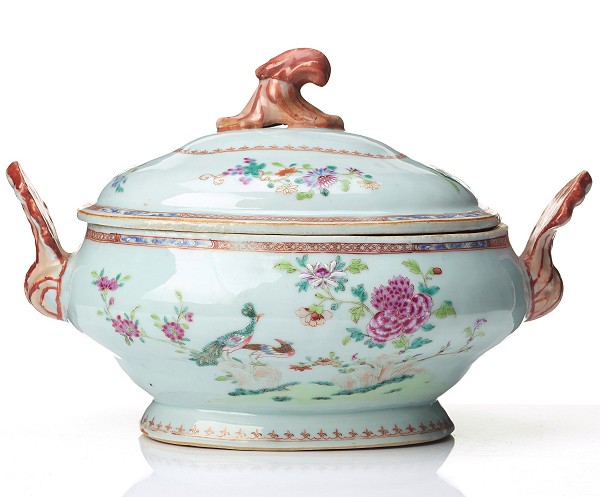
This pattern, known as "Serviço dos Pavões" or "Double Peacock Service", is one of the most famous design in Chinese Export Porcelain, especially in Portugal and Brazil, since a service with this pattern was once owned by the Portuguese King Joao VI, later, Emperor of Brazil.
This pattern, known as "Serviço dos Pavões" or "Double Peacock Service", is one of the most famous designs in Chinese Export Porcelain, especially in Portugal and Brazil.
Estimates say that about twenty thousand pieces of what goes under the name of the "Double Peacock Service" or "Two Peacocks Service") was made between 1750 and 1795. The earlier pieces are usually octagonal while the later are round. It is estimated that today, about 5,000 pieces remains, distributed throughout the world.
Beside being an atractive and well made famille rose design, it fame is based on that the royal family of Portugal once owned a service with this decoration. When Napoleon invaded Portugal, The King Joao VI, soon Emperor of Brazil, while fleeing to exile in Brazil he brought his six Chinese porcelain services with him, including one with this decoration.
The Royal and Imperial family is then said to have used it at the Paço de São Cristóvão and at Fazenda Imperial de Santa Cruz.
It is known as the "viajante" (traveling) service, because it first traveled from China to Portugal, and then from Portugal to Rio de Janeiro. When the Empire turned into the Republic of Brazil, the six Chinese porcelain services of the Joao VI were dispersed through auctions held in 1890 by the auctioneer Joaquin Dias dos Santos, in Rio de Janeiro. Later, the archives of the auction house burned, and since the decoration was not specifically made only for King Joao VI, it is now impossible to distinguish the pieces formerly owned by the King Joao VI from other pieces with this pattern.
Double Peacock porcelains are in the collection of several Brazilian museums, such as the Museum Historico Nacional, the Museu do Estado da Bahia, the Museu Histórico Nacional, the Museu Simões da Silva, the Museu Carlos Costa Pinto, at the Fundação Cultural Ema Gordon Klabin (Brésil) and also in US collections (Reeves center Collection) and others.
A